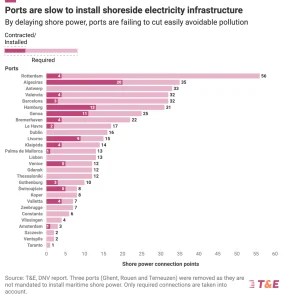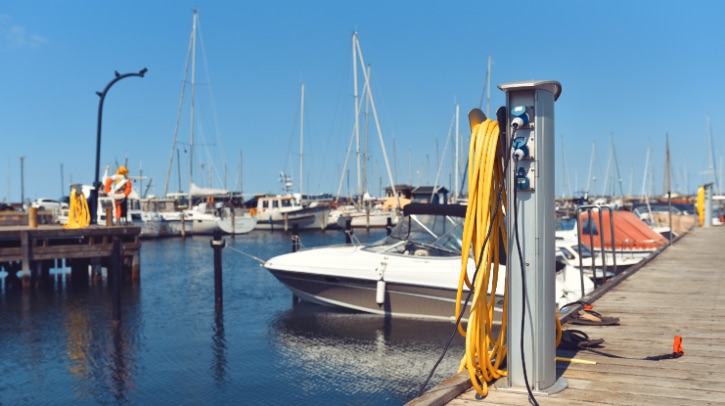According to a study carried out by DNV on behalf of T&E (the European Federation for Transport and Environment), four of the 31 ports studied in Europe have invested in at least half of the shoreside electric infrastructure required by the EU’s 2030 mandate. The study, named European ports unplugged: The state of shore power infrastructure, showed that just 20% of the EU’s required electric shore power infrastructure has been installed or commissioned in major ports to date.
Report findings
The ports of Algeciras, Livorno, Świnoujście and Valletta were the only ones that have installed or contracted more than half of the required OPS installations. The ports of Algeciras and Hamburg also accounted for a large share of the installed onshore power supply (OPS) connections in Europe.
The study found that the ports of Antwerp, Dublin, Gdansk and Lisbon are among those that are yet to invest in any electric plug-in infrastructure. The ports of Rotterdam, Barcelona, Valencia, Bremerhaven and Le Havre also reportedly performed poorly in terms of their efforts to meet the EU mandate.

The following ports did not respond to the researchers before the survey response deadline: Marseille, Dunkerque, Tallinn, Copenhagen/Malmö, Oporto-Leixoes, Gdynia, Helsinki, Varna, Piraeus, Helsingborg, Ploce, Limassol and Marsaxlokk.
The future of the industry
Based on these findings, T&E has called for more ambitious port-side measures to cut air pollution and unnecessary emissions from moored ships. The organization has argued that the EU should bring forward shore power requirements for cruise ships to 2028, ensure ports can earn clean energy credits when ships plug in, dedicate more EU funding for port electrification, and expand the rules to cover all polluting ships, not just the largest passenger and container ships.
Inesa Ulichina, shipping policy officer at T&E, said, “Ports are failing local residents and passengers by allowing unnecessary pollution from idling ships. Electric plug-in technology is available and would reduce shipping’s impact on local air pollution and the climate overnight. For shipping segments that spend a lot of time at ports, like cruise ships, plugging in would be a game-changer.”
Sustainability case study
T&E also highlighted that over 6% of the EU maritime CO2 emissions come from ships running on fossil fuels at ports. Alongside CO2, ships also emit high amounts of sulfur oxides (SOx), nitrogen oxides (NOx) and particulate matter (PM), which affect human health. As part of the EU Green Deal, EU ports are required to provide shore-side electricity to ships by 2030. However, installing shore-side plug-in connections today would improve air pollution in port cities.
![]()
As they spend significantly more time at berth, cruise ships produce more than six times more port-side emissions than container ships. To elucidate the issue, the organization highlighted one example: in 2023, Carnival’s 3,500-passenger Azura cruise ship emitted 22,800 tons of CO2 in European ports. Plugging in at port would reportedly have eliminated almost all of this and cut the ship’s total yearly emissions by a fifth.
In related news, the European Commission recently selected 94 transportation projects to receive nearly €2.8bn (US$3.3bn) in EU grants under the Connecting Europe Facility (CEF). Read the full story here.



